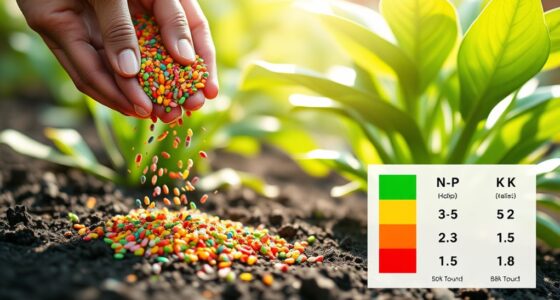Understanding N-P-K ratios helps you choose the right fertilizer for your plants. N stands for nitrogen, which promotes lush, green leaves; P is for phosphorus, encouraging healthy roots and flowers; and K, potassium, boosts disease resistance and fruit quality. Knowing your plants’ specific needs guarantees balanced growth and better yields. By learning how these nutrients work together, you’ll make smarter fertilizing choices. Keep exploring to discover how to optimize your garden’s health and success.
Key Takeaways
- N-P-K ratios indicate the relative amounts of nitrogen, phosphorus, and potassium in fertilizers, guiding nutrient balance for plant needs.
- Nitrogen promotes green foliage, phosphorus supports roots and flowering, potassium enhances disease resistance and fruit quality.
- Different plants and growth stages require specific N-P-K ratios for optimal health and productivity.
- Proper fertilizer application, based on soil tests and instructions, prevents over- or under-fertilizing.
- Organic fertilizers release nutrients slowly, improve soil health, and support sustainable gardening practices.

Ever wondered how to boost your garden’s growth effectively? One of the key factors is understanding how fertilizers work and what your plants truly need. Before jumping into chemical blends, it’s worth considering soil amendments, especially organic options. These improve soil quality naturally, providing a healthy foundation for your plants to thrive. Organic options like compost, manure, and kelp meal enrich the soil with essential nutrients and enhance its structure, making nutrients more accessible to plant roots. Using soil amendments can also boost microbial activity, which helps break down organic matter and release nutrients slowly and steadily. This approach not only supports plant growth but also promotes sustainable gardening practices. Creativity can be cultivated by experimenting with different organic amendments to discover what best supports your garden’s unique ecosystem.
When it comes to fertilizers, understanding the N-P-K ratio is vital. This ratio indicates the relative amounts of nitrogen (N), phosphorus (P), and potassium (K) in a product. Nitrogen fuels lush, green foliage; phosphorus encourages strong root development and flowering; and potassium helps plants resist disease and improves fruit quality. Different plants and growth stages require varying balances of these nutrients. For example, leafy vegetables need more nitrogen, while flowering plants benefit from increased phosphorus. Recognizing these needs allows you to select the right fertilizer, ensuring your plants get exactly what they require at each stage of growth.
Applying fertilizers correctly is equally important. Over-fertilizing can lead to nutrient runoff, which harms the environment, and can also cause your plants to become stressed or develop weak structures. Under-fertilizing, on the other hand, results in poor growth and reduced yields. Always follow the manufacturer’s instructions and consider your soil’s current nutrient levels, which you can determine through soil testing. This way, you avoid unnecessary waste and guarantee your plants receive balanced nutrition.
Incorporating organic options into your fertilizing routine offers multiple benefits. Organic fertilizers release nutrients slowly, preventing overfeeding and reducing the risk of burn. They also improve soil health over time, making your garden more resilient. Compost, for example, supplies a broad spectrum of nutrients along with beneficial microorganisms, creating a more vibrant and sustainable soil ecosystem. Organic options often work synergistically with soil amendments to create an environment where plants can flourish naturally. Combining these strategies helps you build a healthier garden that’s less reliant on synthetic inputs, supports biodiversity, and produces better, more flavorful produce.
Ultimately, understanding the roles of soil amendments, organic options, and the N-P-K ratio empowers you to make smarter decisions about fertilizing. This knowledge helps you nurture your plants effectively, encourage healthy growth, and enjoy a thriving garden for seasons to come.
Frequently Asked Questions
How Often Should I Fertilize My Houseplants?
You should fertilize your houseplants every 4 to 6 weeks during their active growing season, adjusting based on watering frequency and plant type. Regular fertilization promotes healthy growth and can help prevent pests by keeping plants strong. In winter, cut back on feeding as growth slows. Always monitor your plants for signs of overfeeding or nutrient deficiencies, and make sure to balance fertilizing with proper watering and pest prevention techniques.
Can I Use Organic and Synthetic Fertilizers Together?
Yes, you can combine organic blends with synthetic fertilizers, but you should consider synthetic compatibility. Mixing them can boost nutrient availability, but avoid over-fertilizing, which can harm your plants. Always follow label instructions and adjust based on your plant’s needs. Using both types can provide balanced nutrition, but monitor your plants closely to prevent nutrient overload or deficiencies. This approach offers flexibility and promotes healthy growth.
What Signs Indicate My Plants Need More Nutrients?
If your plants show signs of nutrient deficiencies, you’ll notice leaf discoloration, such as yellowing or browning edges. You might also see stunted growth or weak stems. These symptoms indicate they need more nutrients. Pay close attention to changes in leaf color and overall vigor, and consider supplementing with appropriate fertilizers to restore balance. Regular observation helps you catch deficiencies early and keep your plants healthy.
Are There Fertilizers Suitable for All Plant Types?
Ever wondered if one fertilizer fits all your plants? While universal fertilizers are designed to provide general nutrients, they might not meet all plant-specific needs. Different plants have unique nutrient requirements, so using specialized fertilizers guarantees ideal growth. Don’t assume one size fits all—check your plants’ specific nutrient needs to choose the right fertilizer. This way, you support healthy, vibrant plants tailored to each type.
How Do Soil Ph Levels Affect Fertilizer Effectiveness?
Soil pH levels substantially influence fertilizer effectiveness. If your soil is too acidic or alkaline, it affects nutrient absorption, making fertilizers less effective. Soil acidity can lock up essential nutrients, preventing plants from accessing them, while proper pH guarantees ideal nutrient uptake. To enhance fertilizer performance, test your soil regularly and adjust pH levels if needed, so your plants can absorb nutrients efficiently and thrive.
Conclusion
Now that you understand N-P-K and your plants’ needs, you’ll make smarter fertilizing choices. Remember, over-fertilizing can harm your garden just as much as under-fertilizing. Did you know that applying too much fertilizer can cause runoff, polluting nearby waterways? By knowing what your plants need and using fertilizers responsibly, you’ll nurture a thriving, healthy garden—and help protect the environment too. Happy gardening!









